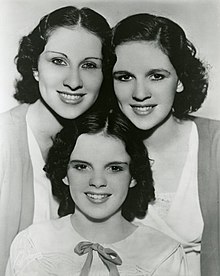The Gumm Sisters
This article needs additional citations for verification. (January 2025) |
The Gumm Sisters | |
|---|---|
 The Gumm Sisters, also known as the Garland Sisters, c. 1935: Top row: Mary Jane and Dorothy Virginia Gumm; bottom: Judy Garland | |
| Background information | |
| Origin | Lancaster, California, U.S. |
| Genres | Vaudeville |
| Years active | 1924–1935 |
| Members |
|
The Gumm Sisters, later also known as The Garland Sisters, were an American vaudeville group formed by the three children of Francis Avent Gumm and Ethel Marion Milne: Judy Garland, Dorothy Virginia Gumm, and Mary Jane Gumm. Active from 1924 to 1935, the sisters were known for their vocal harmonies, dance routines, and stage presence.
They performed in theaters, on the radio, and in short films, gaining regional recognition. The group changed its name to The Garland Sisters in 1934, following the suggestion of comedian George Jessel, and Frances Gumm adopted the stage name "Judy Garland." Although the Gumm Sisters had a notable presence in the entertainment industry, Garland's solo career became the focus of the family's efforts after she signed with Metro-Goldwyn-Mayer in 1935, marking the end of the trio's performances together.[1][2][3]
Career
[edit]Early beginnings (1924–1934)
[edit]
The Gumm Sisters began performing together in 1924, with guidance from their parents, both of whom were vaudeville performers. Frank Gumm owned a theater in Grand Rapids, Minnesota, where the family performed, often showcasing a mix of song, dance, and comedy. The sisters’ early performances gained attention for their vocal harmonies and energetic stage presence.[4][5][6]

The family moved to California in the late 1920s to pursue greater opportunities in the entertainment industry. Ethel Gumm, their mother, played a central role in managing their career, securing bookings for them in Hollywood and other regional performances. The Gumm Sisters began appearing in radio programs and were also featured in short films. Over the next few years, they performed in various theaters and local venues, gaining recognition in the Los Angeles area for their dynamic performances.[1]
Rise to Prominence (1934–1935)
[edit]In 1934, the Gumm Sisters performed at the Chicago World’s Fair, which contributed to their increasing visibility in the entertainment world. Around this time, they also appeared in several short films. It was also during this period that the group officially adopted the stage name "The Garland Sisters," following a suggestion from comedian George Jessel. Jessel believed the new name would be more marketable and suitable for the group’s image. Frances Gumm, who was performing as part of the group, also began using the stage name "Judy Garland".[2][7][8]
Despite their success, Judy Garland’s solo career began to take precedence. In 1935, she signed with MGM after a standout solo performance, marking the beginning of her rise as a solo artist. The focus on Judy Garland’s individual career, including her signing with MGM, led to the disbanding of The Garland Sisters as a performing act.[3][1][9]
Legacy and impact
[edit]While The Gumm Sisters’ active years were relatively short, their performances contributed to the early career of Judy Garland, laying the foundation for her solo success. The sisters' experience in vaudeville and their appearances in early short films reflected the larger entertainment landscape of the time. Judy Garland’s eventual rise to fame overshadowed the group's legacy, but the early years of The Gumm Sisters remain a part of Garland’s history and the broader entertainment history of the 1920s and 1930s.[4]
Filmography
[edit]| Title | Year | Role | Studio | Type | References |
|---|---|---|---|---|---|
| The Big Revue | 1929 | Themselves (as The Gumm Sisters) | Mayfair Pictures | Short film | |
| A Holiday in Storyland | 1929 | First National Pictures | Short film | ||
| The Wedding of Jack and Jill | 1930 | First National Pictures | Short film | ||
| Bubbles | 1930 | First National Pictures | Short film | ||
| La Fiesta de Santa Barbara | 1935 | Themselves (as The Garland Sisters) | Metro-Goldwyn-Mayer | Short film | [10] |
References
[edit]- ^ a b c Finch, Christopher (1975). Rainbow: The Stormy Life of Judy Garland. Grosset & Dunlap. ISBN 978-0448117317.
- ^ a b Luft, Lorna; Vance, Jeffrey; Movies, Turner Classic (2018-09-18). A Star Is Born: Judy Garland and the Film that Got Away. Running Press. ISBN 978-0-7624-6480-7.
- ^ a b Fantle, David; Johnson, Tom (2023-10-10). C'mon, Get Happy: The Making of Summer Stock. Univ. Press of Mississippi. ISBN 978-1-4968-4658-7.
- ^ a b Stanton, Scott (2003). The Tombstone Tourist: Musicians. Simon and Schuster. ISBN 978-0-7434-6330-0.
- ^ "About | Judy Garland". Judy Garland | Your official home for the latest Judy Garland News.
- ^ Lobosco, David (2016-06-10). "A TRIP DOWN MEMORY LANE: JUDY GARLAND AND THE GUMM SISTERS". A TRIP DOWN MEMORY LANE. Retrieved 2025-01-26.
- ^ "Judy Garland 1922-1934". The Judy Room.
- ^ "Judy Garland". U-S-History.com.
- ^ "Over the Rainbow: The Judy Garland Story". LiveAbout. Retrieved 2025-01-26.
- ^ "Gumm Sisters Shorts". The Judy Room.
